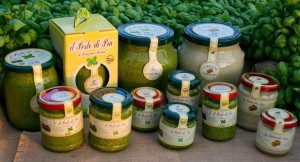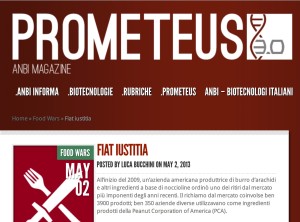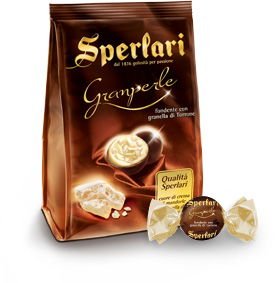It’s better to rely on locals who know their stuff, so I turned to our Italian food safety friend, Luca Bucchini to clarify the alleged-botulism-in-pesto story. He writes:
There was probably no botulin toxin in the Italian basil pesto that sent more than 100 people to the emergency departments across Italy. Of the 100, 10 have been initially hospitalised, but 8 were later sent home: none had symptoms which suggested botulism. While tests on products and humans are still pending, the toxin has yet to be found in any sample.
The company, Bruzzone and Ferrari, which has been producing basil for pesto for two centuries, had identified a “potentially pathogenic microorganism” in a lot of its pesto: it is widely believed that the organism was C. botulinum, the bacterium which  can, under certain conditions, produce the lethal toxin. The product, which is a fresh sauce requiring refrigeration, was already on the market: when the shelf life of a product is relatively short and time required for testing is relatively long, products are shipped before the results of the testing are known. This procedure is often required by retailers. When Bruzzone and Ferrari realised that they had a positive finding for the pathogen, though not for the toxin, they decided to issue a recall; a public recall is uncommon in Italy.
can, under certain conditions, produce the lethal toxin. The product, which is a fresh sauce requiring refrigeration, was already on the market: when the shelf life of a product is relatively short and time required for testing is relatively long, products are shipped before the results of the testing are known. This procedure is often required by retailers. When Bruzzone and Ferrari realised that they had a positive finding for the pathogen, though not for the toxin, they decided to issue a recall; a public recall is uncommon in Italy.
Italy’s Ministry of Health, usually stingy with information, issued a Press Release (http://www.salute.gov.it/portale/news/p3_2_4_1_1.jsp?lingua=italiano&menu=salastampa&p=comunicatistampa&id=4053) on July 20, 2013, calling the incident an “alarm” and explained that the botulin toxin is potentially fatal. However, it failed to mention the retail brands under which the product was sold, and did not offer advice to consumers, for example on when to seek medical care. Only the lot, the sell-by date and the producer’s name were mentioned; it was assumed that consumers are able to scan the back of the label and identify the small print needed to identify the producer. The press release also suggested that products were mostly off the shelf and the recall was limited. Ministry of Health press releases are immediately taken up by the main press agencies, and automatically become major news.
It soon became apparent that 15,000 jars were affected, and that many consumers had eaten the product, which had been on the market for at least a week; there was no information for them in the official communication. Panic ensued. Officials communicated sparingly, with the exception of Liguria, the region where the company is based. Hospitals were slow to explain that no cases were confirmed and that people without symptoms did not need hospitalisation; the Facebook site of Bruzzone & Ferrari was the  only formal source of information, with only a few independent media outlets providing further details. The affected lot had been sold under several brands, including those of Italy’s top supermarket chains. The supermarket chains posted alert signs in shops and frantically e-mailed and phoned customers with loyalty cards to inform them of the recall; they probably hoped to avoid going public. As consumers reported about the calls received on Facebook and on other sites, some eventually capitulated and published on their website a recall notice, while others are still silent.
only formal source of information, with only a few independent media outlets providing further details. The affected lot had been sold under several brands, including those of Italy’s top supermarket chains. The supermarket chains posted alert signs in shops and frantically e-mailed and phoned customers with loyalty cards to inform them of the recall; they probably hoped to avoid going public. As consumers reported about the calls received on Facebook and on other sites, some eventually capitulated and published on their website a recall notice, while others are still silent.
At this point in time, it seems likely that there was no toxin in most or all jars, and that people sought medical attention for reasons unrelated to product content. Some suspect that other pathogens may be present; however, no specific information supports this, and reported symptoms by few patients (vomit, diarrhea) may be unrelated to the exposure.
Nevertheless, the presence of the toxin in some jars cannot be excluded. The product does not appear to be heat-treated; it is part of a broad global trend to produce raw, semi-raw fresh products which require refrigeration. The pH of the product is permissive for growth of botulin (specifications: 4.8-5.8); it is rich in oil providing anaerobic conditions; it is used on pasta as a sauce without cooking; it has a shelf life of 30 days. While the product is to be refrigerated, the cold chain, especially in summer, with ambient temperatures above 30 C, is often not reliable: retailers often don’t prioritise temperature control. Consumers may not understand the difference between shelf-stable pesto (which is more common) and the refrigerated variety, or underestimate the importance of refrigeration.
Though food safety officials praised the company for not hesitating to issue a public recall, magistrates, as it is usual in Italy, were quick to start a criminal investigation for alleged unintentional injuries. In Italy, companies fear issuing precautionary recalls as magistrates generally try and convict in criminal court those who publicly confess to the mere presence of a pathogen in their products. This has been a factor in the hesitation of businesses to embrace European food law which requires issuing immediate recalls.
Overall, it is early to draw final conclusions from this episode. Hopefully, the results of the testing will be made public and confirm that there was no outbreak (incidentally, Italy has an ongoing foodborne Hepatitis A outbreak with hundreds of cases of which were little is being said). It is perhaps time to question products which, while nicely fresh, depend on the cold chain for being safe from botulin. It is quite clear that the authorities, and particularly the Ministry of Health, need risk communication training: consumers need to reliably identify products, get quickly rid of them, and not rush to the ER if they don’t need to.








 Police seized assets worth more than £78 million, including the company.
Police seized assets worth more than £78 million, including the company. kindergarten who have been hospitalized at the Pesenti Fenaroli hospital in Alzano.
kindergarten who have been hospitalized at the Pesenti Fenaroli hospital in Alzano..png) surveillance of all notifiable human infectious diseases. Both systems are Internet based.
surveillance of all notifiable human infectious diseases. Both systems are Internet based.  on much. A recall for foreign bodies is also exceptional as officials don’t mind foreign bodies much. What is typically Italian is the threatening message at the end: we tell the public because we have to, but we will sue you if you talk about it to anyone, or you link to our page.
on much. A recall for foreign bodies is also exceptional as officials don’t mind foreign bodies much. What is typically Italian is the threatening message at the end: we tell the public because we have to, but we will sue you if you talk about it to anyone, or you link to our page.